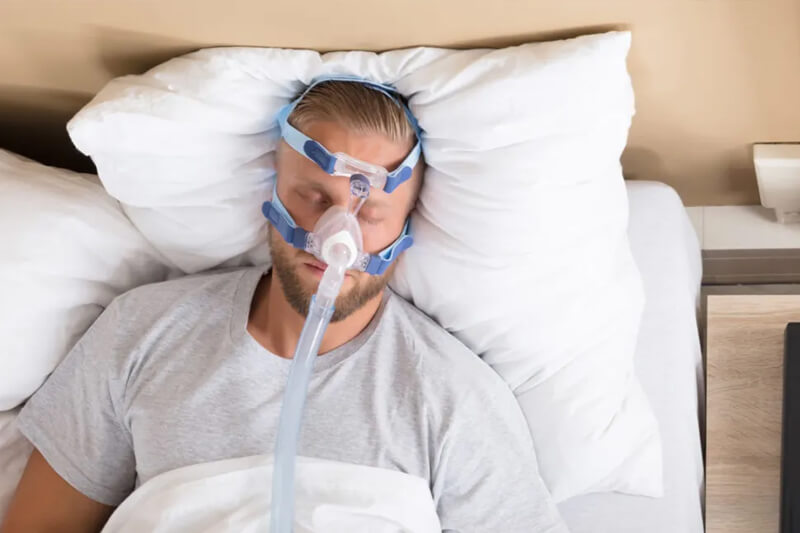What is sleep aplnea ?
Sleep apnea is a sleep disorder characterized by repetitive pauses in breathing or shallow breathing during sleep. These pauses in breathing can last for a few seconds to minutes and may occur multiple times throughout the night. Sleep apnea disrupts the normal sleep pattern and can lead to poor sleep quality and daytime fatigue.
Possible Causes of Sleep apnea
Sleep apnea can have various causes, and it’s often a combination of factors that contribute to the development of the condition. The two primary types of sleep apnea, obstructive sleep apnea (OSA) and central sleep apnea (CSA), have different underlying causes:
- Obstructive Sleep Apnea (OSA) Causes:
- Excess weight: Obesity is one of the most significant risk factors for OSA. The presence of excess fat in the neck area can narrow the airway, making it more prone to collapse during sleep.
- Narrow airway: Some individuals may naturally have a narrower airway due to genetics or anatomical factors, which can increase the risk of airway obstruction during sleep.
- Enlarged tonsils or adenoids: Children with enlarged tonsils or adenoids may be more susceptible to OSA.
- Age: OSA is more common in older adults due to age-related changes in muscle tone and tissues in the throat.
- Gender: Men are more likely to develop OSA than women, although the risk for women increases if they are overweight.
- Alcohol and sedative use: Consuming alcohol or taking sedative medications before bedtime can relax the throat muscles and contribute to airway collapse.
- Central Sleep Apnea (CSA) Causes:
- Heart disorders: CSA can be associated with heart failure, atrial fibrillation, or other cardiac conditions that affect the brain’s control of breathing.
- Neurological disorders: Certain neurological conditions, such as stroke, brainstem lesions, or encephalitis, can disrupt the brain’s respiratory control center, leading to CSA.
- Mixed Sleep Apnea Causes:
- Mixed sleep apnea is a combination of obstructive and central sleep apnea, and its causes may involve elements of both types.
Other Risk Factors:
- Family history: Having a family history of sleep apnea may increase the likelihood of developing the condition.
- Smoking: Smoking can contribute to inflammation and fluid retention in the upper airway, increasing the risk of OSA.
- Nasal congestion: Chronic nasal congestion or structural issues in the nose can make breathing difficult during sleep and contribute to sleep apnea.
- Medical conditions: Certain medical conditions, such as hypothyroidism and acromegaly, can increase the risk of sleep apnea.
It’s essential to recognize the potential risk factors and seek medical evaluation if you or someone you know experiences symptoms of sleep apnea. Proper diagnosis and treatment can help manage the condition and improve overall sleep quality and health.
Signs & Symptoms of Sleep apnea
Sleep apnea can manifest through various signs and symptoms, which may vary depending on the type and severity of the condition. The common signs and symptoms of sleep apnea include:
- Loud and chronic snoring: Snoring, particularly loud and consistent snoring, is one of the most common symptoms of sleep apnea. It is more prevalent in obstructive sleep apnea (OSA).
- Pauses in breathing during sleep: The hallmark symptom of sleep apnea is the recurrent cessation of breathing during sleep. These pauses can last a few seconds to minutes and may be followed by gasping or choking.
- Excessive daytime sleepiness: People with sleep apnea often experience significant daytime sleepiness, even after a full night’s sleep. They may struggle to stay awake during daily activities, leading to reduced productivity and an increased risk of accidents.
- Fragmented sleep: Sleep apnea disrupts the normal sleep cycle, causing frequent awakenings throughout the night. As a result, individuals with sleep apnea may not feel refreshed upon waking and may experience difficulty falling back asleep.
- Fatigue and lack of energy: Due to poor sleep quality, individuals with sleep apnea may feel fatigued and have reduced energy levels during the day.
- Morning headaches: Morning headaches are a common complaint in people with sleep apnea, often caused by the intermittent oxygen deprivation during sleep.
- Dry mouth and sore throat: Breathing through the mouth during sleep, which is common in sleep apnea, can lead to a dry mouth and a sore throat upon waking.
- Irritability and mood changes: Sleep apnea can contribute to irritability, mood swings, and difficulty managing stress.
- Memory and concentration problems: Sleep apnea can affect cognitive function, leading to memory issues, difficulty concentrating, and impaired decision-making.
- Decreased libido and sexual dysfunction: Sleep apnea may lead to a decrease in sex drive and sexual dysfunction in both men and women.
It is important to note that not everyone with sleep apnea will experience all of these symptoms, and the severity of symptoms can vary. If you or someone you know exhibits any of these signs, especially if they are accompanied by loud snoring and pauses in breathing during sleep, it is essential to seek medical evaluation and possibly a sleep study (polysomnography) to diagnose and properly manage sleep apnea. Early detection and treatment of sleep apnea can improve sleep quality and overall health.
How Diagnosis sleep apnea ?
Diagnosing sleep apnea typically involves a combination of medical history evaluation, physical examination, and sleep studies. If you suspect you have sleep apnea or have been experiencing symptoms such as loud snoring, pauses in breathing during sleep, and excessive daytime sleepiness, it is essential to seek evaluation from a healthcare professional, preferably a sleep specialist or a pulmonologist.
Here are the common steps involved in diagnosing sleep apnea:
- Medical History: Your healthcare provider will begin by taking a detailed medical history, including asking about your sleep patterns, daytime symptoms, and any underlying medical conditions that may be contributing to your sleep problems.
- Physical Examination: A physical examination may be conducted to assess your overall health and identify any physical factors that could be related to sleep apnea, such as obesity, enlarged tonsils, or nasal congestion.
- Sleep Questionnaires: Your doctor may ask you to fill out sleep questionnaires or assessments to help gauge the severity of your sleep symptoms and the impact on your daily life.
- Sleep Study (Polysomnography): The most definitive way to diagnose sleep apnea is through a sleep study, also known as polysomnography. During a sleep study, you will spend a night at a sleep center or clinic while various sensors and monitors are attached to your body to record data during sleep. These monitors may include:
- Electroencephalogram (EEG): To monitor brain activity.
- Electrooculogram (EOG): To monitor eye movements.
- Electromyogram (EMG): To monitor muscle activity.
- Electrocardiogram (ECG): To monitor heart activity.
- Respiratory effort belts: To monitor chest and abdominal movements.
- Pulse oximeter: To measure blood oxygen levels.
- Airflow sensor: To monitor airflow through the nose and mouth.
The sleep study records your sleep stages, breathing patterns, snoring, and other physiological parameters. This data is then analyzed by sleep specialists to determine if you have sleep apnea and to determine its type and severity.
- Home Sleep Apnea Test (HSAT): In some cases, a home sleep apnea test may be used for initial screening, especially for patients with a high suspicion of obstructive sleep apnea. The HSAT involves wearing simplified monitoring equipment at home while you sleep. If the results are positive for sleep apnea, a follow-up in-lab polysomnography may be recommended for a more comprehensive evaluation.
Once the diagnosis is confirmed, your healthcare provider will work with you to develop an appropriate treatment plan based on the type and severity of sleep apnea you have. Common treatment options include continuous positive airway pressure (CPAP) therapy, oral appliances, lifestyle changes, and in some cases, surgery.
Remember that proper diagnosis and treatment of sleep apnea are essential for improving sleep quality, overall health, and reducing the risk of associated health complications.
What Treatment for sleep apnea ?
The treatment for sleep apnea depends on the type and severity of the condition. There are three main types of sleep apnea: obstructive sleep apnea (OSA), central sleep apnea (CSA), and mixed sleep apnea (a combination of obstructive and central). Here are the common treatment options for each type of sleep apnea:
- Obstructive Sleep Apnea (OSA) Treatment:
- Continuous Positive Airway Pressure (CPAP): CPAP therapy is the most common and effective treatment for OSA. It involves wearing a mask over the nose or mouth during sleep, and a CPAP machine delivers a continuous stream of air, which helps to keep the airway open. CPAP prevents airway collapse and reduces snoring and apnea episodes.
- Bi-level Positive Airway Pressure (BiPAP): BiPAP is similar to CPAP but delivers different air pressure levels during inhalation and exhalation. It is sometimes used for individuals who have difficulty tolerating CPAP or have specific breathing patterns.
- Oral Appliances: Oral appliances are custom-made devices that are worn in the mouth during sleep. They help reposition the jaw and tongue to keep the airway open. Oral appliances are usually recommended for mild to moderate OSA or for individuals who cannot tolerate CPAP.
- Lifestyle Changes: Making certain lifestyle changes can help improve OSA symptoms. These include weight loss (if overweight), avoiding alcohol and sedatives before bedtime, sleeping on your side, and treating nasal congestion or allergies.
- Surgery: In severe cases of OSA or when other treatments have not been successful, surgery may be considered. Surgical options include uvulopalatopharyngoplasty (UPPP), genioglossus advancement, hyoid suspension, and maxillomandibular advancement, among others.
- Central Sleep Apnea (CSA) Treatment:
- Treatment of Underlying Medical Conditions: The primary approach to treating CSA is to address any underlying medical conditions that may be causing the central respiratory control dysfunction. This may include managing heart failure, atrial fibrillation, or other cardiac disorders.
- Adaptive Servo-Ventilation (ASV): ASV is a type of positive airway pressure therapy that helps maintain a stable breathing pattern by providing varying levels of pressure support during inhalation and exhalation.
- Medications: Certain medications, such as acetazolamide, may be prescribed to help stimulate respiratory drive and improve CSA in specific cases.
- Mixed Sleep Apnea Treatment:
The treatment for mixed sleep apnea usually involves a combination of therapies for both obstructive and central components, depending on the predominant symptoms.
It’s essential to work with a sleep specialist to determine the most appropriate treatment for your specific type and severity of sleep apnea. Proper treatment can significantly improve sleep quality, reduce daytime symptoms, and decrease the risk of associated health problems. Additionally, lifestyle changes, such as maintaining a healthy weight, avoiding alcohol and smoking, and practicing good sleep hygiene, can complement medical treatments and contribute to better sleep and overall well-being.



